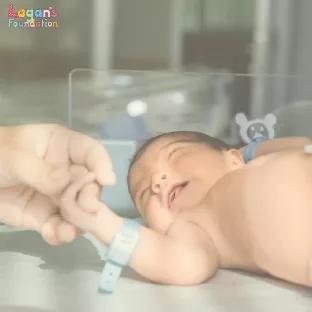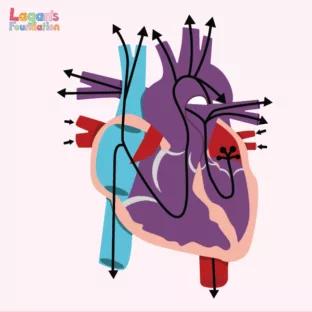Understanding Aortic Valve Stenosis in Children
Valve Condition

Aortic Valve Stenosis is one of the most common and serious valve conditions that can be present at birth or develop later in childhood. It is sometimes referred to as the failing of the heart valve.
In this guide, we’ll discuss what exactly Aortic Valve Stenosis is, what the symptoms are and what treatment options are available for children who suffer from the condition.
Key Points:
- Aortic Valve Stenosis means a valve in your child’s heart is too narrow or blocked.
- The condition can be mild, moderate or severe.
- Several procedures are available to treat the defect and children who receive surgery will most likely live long, healthy lives.
What is Aortic Valve Stenosis in children?
Aortic Valve Stenosis (AVS) is a condition that occurs in children when the aortic valve in the heart is too narrow, or is blocked, making it difficult to pump blood around the body.
A normal aortic valve has 3 cups, or leaflets, that act as a one way door for the blood to flow through. However, with AVS, the valve doesn’t work as it should and may have an abnormal number of cups that don’t work correctly. This makes it harder for the cups to open and let the blood flow from the left ventricle to the aorta.
Aortic Valve Stenosis can be either congenital, meaning it is present at birth, or it can happen later in life, which is sometimes referred to as acquired.
What causes Aortic Valve Stenosis?
Like many congenital heart conditions, the true cause of Aortic Valve Stenosis is not known. However, it is commonly thought that AVS is caused by genetic problems that occur during pregnancy which causes the aortic valve to form incorrectly.
AVS can be acquired later in life in older children if they have had an untreated strep infection.
What are the symptoms of Aortic Valve Stenosis in children?
Symptoms of Aortic Valve Stenosis can vary depending on the severity of the condition, as well as how old the child is. Some children and babies may not even show any symptoms and they may not develop until adulthood.
In severe cases of Aortic Valve Stenosis, symptoms can include:
- Fatigue
- Trouble or difficulty feeding
- Dizziness and lightheadedness while exercising
- Fainting
- Shortness of breath
- Rapid breathing
- Palpitations
- Chest pains or pressure
- Arrhythmia
- Trouble gaining weight
Symptoms of AVS can be similar to other conditions, which is why it is important you speak to a healthcare professional to get the right diagnosis.
How is Aortic Valve Stenosis diagnosed in children?
During a health check, your child’s doctor or nurse may have noticed a heart murmur when listening to your child’s chest with a stethoscope. A heart murmur may be the sign that your child has a heart condition and they will likely be referred to a paediatric cardiologist to confirm the diagnosis.
How is Aortic Valve Stenosis in children treated?
How Aortic Valve Stenosis is treated will depend on your child’s age, symptoms and general health. If your child doesn’t have any symptoms or they are just mild, their doctor may just watch the symptoms closely.
To help diagnose the condition, your child may have one or more or the following tests:
-
- Chest X-Ray – This gives an overall picture of your child’s heart and lungs.
- Electrocardiogram (ECG) – This means testing the electrical activity of the heart.
- Echocardiogram – This test uses sound waves to give a moving picture of the heart and valves, making it one of the best tests for AVS.
Cardiac Catheterisation – This test shows the structure of the heart. The doctor will put a thin tube in your child’s blood vessels and slowly guide it to the heart while your child is asleep.

If you child does need surgery, there are several surgery options available:
- Balloon Aortic Valvuloplasty – This is done with cardiac catheterisation using a catheter with a deflated balloon in the tip. The catheter is put into a blood vessel and is moved into the narrow valve. The balloon is then inflated to open the valve.
- Surgical Aortic Valvotomy – This surgery removes scar tissue from the aortic valve cups, allowing them to open as they should.
- Aortic Valve Replacement – This surgery is to replace the aortic valve with a new valve. The new valve will usually either be an artificial one or from a donor.
- Pulmonary Autograft (Ross Procedure) – This surgery is to replace the aortic valve and part of the aorta by using your child’s own pulmonary valve and pulmonary artery. Many doctors prefer this method as it continues to work well as your child grows.
View our PDF Guide
What is the life expectancy of a child with Aortic Valve Stenosis?
Without the correct treatment, a child with Aortic Valve Stenosis will have a shortened life expectancy with the average survival rate for patients with severe AVS having a 50% survival rate at two years of age.
Those who receive treatment and surgery for their AVS will have an increased lifespan, with many going on to live long, healthy and active lives. Your child’s activity levels and appetite will also return to normal, helping them grow and develop like other children.
Are there complications of Aortic Valve Stenosis in children?
There are a few possible complications of Aortic Valve Stenosis if it goes untreated. These complications can include:
- Bulging or weakening of the aorta, known as an aneurysm
- Tearing of the aorta
- Infection in the lining of the heart, valves or blood vessels
- Heart failure
Your child’s doctor will discuss the possibility of any of these complications with you during their check-ups and appointments.
Are there other conditions associated with Aortic Valve Stenosis?
If Aortic Valve Stenosis is left untreated, it can lead to other issues such as diabetes, high blood pressure and high cholesterol. Your child may also have other heart conditions, such as those that affect the aorta or mitral valve.
Other conditions can include Aortic Valve Calcification, which is a calcium build-up on the valve that can cause stiffening of the valve cups at a young age.

![Understanding Total Anomalous Pulmonary Venous Return [TAPVR]](/wp-content/uploads/2025/04/Understanding-Total-Anomalous-Pulmonary-Venous-Return-FI-312x312-c-default.jpg)


